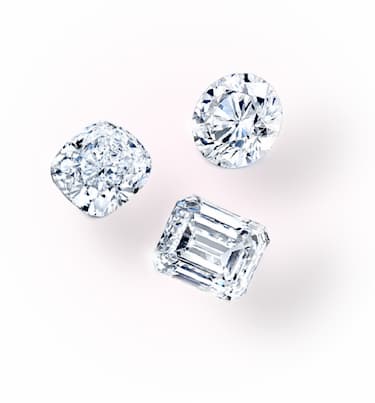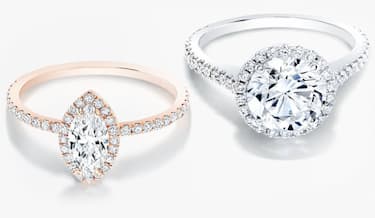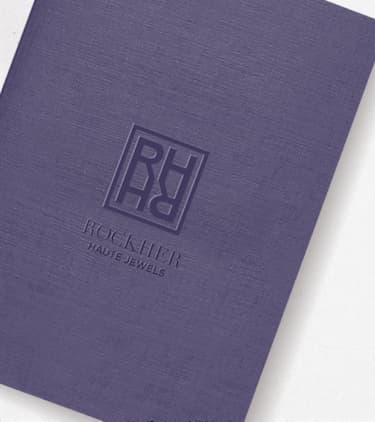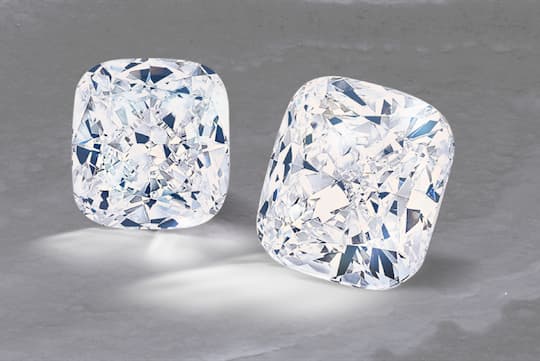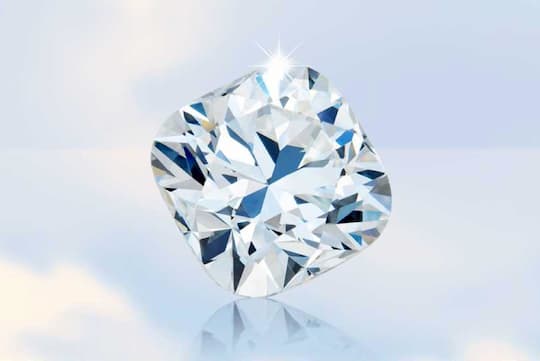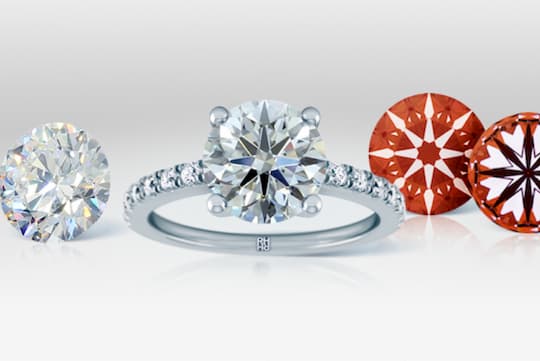At RockHer, we make sure that all the loose diamonds we sell are brilliant and beautiful forever.
All our diamonds are conflict free and responsibly sourced and many of them can be traced to
their source. At RockHer, we also give you the choice between loose natural diamonds
and loose lab grown diamonds.
By shopping for loose diamonds, you’ve made certain that you can choose the exact size, shape
and quality you want at a very competitive price. The quality of your loose diamond is backed
by independent certification from an internationally recognized diamond grading laboratory.
We offer both GIA-certified diamonds, with reports from the prestigious Gemological Institute
of America, and IGI-certified diamonds, with reports from the largest gem grading laboratory.
That means that you can select the color, cut, clarity, and carat weight that suit you best. We
can help you assess each of the 4Cs of diamond quality to get the best balance of quality and
value for your budget. You can also use our digital gemologist ROSI to find the best diamond for
you, using artificial intelligence powered by IBM’s Watson. Here’s what you need to know
about the 4Cs to judge the quality of your diamond.
The Best Diamond Color
Diamond color starts at completely colorless and ranges in a continuous gradient to diamonds
with noticeable colors, called fancy colored diamonds. Most diamonds on the market are
colorless or faintly colored. In the 1950s, the Gemological Institute of America developed a
grading scale to accurately describe the amount of color in a diamond.
The diamond color grading scale starts at D, which is completely colorless, and ends at Z, which
is a faint fancy colored diamond. Diamond color is also a measure of rarity: D color diamonds
have almost no color-causing impurities like nitrogen, which creates yellow, so they are very
rare. Diamonds with more impurities are less rare.
Gemologists grade diamond color with the gems upside down, so the brilliance of the diamond
doesn’t distract the eye. The grader compares the diamond to master stones which represent
each color grade. The differences between adjacent grades is subtle, so it can best be seen
through comparing diamonds side-by-side.
When you are shopping for a loose diamond, it’s helpful to think in categories rather than
specific color grades. Grades D, E and F are colorless, with no color visible to the eye in the face
up position. Grades G, H and I are near-colorless: their tints are slight and difficult to see in the
face-up position. Grades J, K, and L have tints that can easily be seen in the face up position.
What is the best diamond color for you? In general, we think that the H color grade offers the
best combination of quality and value. If you are setting your diamond in yellow or rose gold,
you may decide to choose an I or J color because the slight tint won’t be as visible when the
diamond is set. If you are choosing a diamond shape in a step-cut shape like and emerald or
Asscher cut or a fancy shape with points which tend to concentrate color, like a pear, marquise,
or heart, you might choose a G color.
The Best Diamond Clarity
The tiny clarity characteristics inside a diamond are like a fingerprint, making each gem unique.
Most are tiny minerals, fissures, and growth marks trapped inside as the crystal grew. Others
are marks on the surface left during the polishing process. Diamonds can even be identified by
the pattern of their inclusions in three dimensions.
Diamond clarity is graded under 10x magnification, which is the magnification of a jeweler’s
loupe. Diamonds with the highest clarity grades, Flawless, Internally Flawless, and Very Very
Slightly Included grades (Fl, IF, VVS1 and VVS2) have clarity characteristics that are impossible
or very difficult for professionals to see with 10x magnification. Very Slightly Included grades
(VS1 and VS2) have minor inclusions that a skilled grader can see with 10x magnification.
Slightly Included grades (SI1 and SI2) have inclusions that skilled graders can easily see under
10X magnification. Included grades (I) have inclusions that are visible without magnification.
When you are looking at diamond photos online, of course, you’ll easily be able to see the
inclusions because the images are usually blown up in size much more than 10x. Imagine that
one carat diamond only 6.4mm across and the inclusions will be invisible.
What is the best diamond clarity for you? At RockHer, we recommend VS2 and SI1 clarity
grades for the best balance of beauty and value. No matter what the grade, ROSI looks for the
type and location of inclusions to make sure that they will not affect the beauty of your
diamond.
The Best Diamond Cut
Before they are cut, diamonds just look like transparent pebbles. It’s the cutter’s art that gives a
diamond brilliance, fire and scintillation. When you are considering cut, it’s more than just the
shape of a diamond. It’s also the angles and proportions that reflect and refract the light. At
RockHer, we recommend choosing an excellent or ideal cut diamond whenever possible to
make sure that your diamond sparkles with light and life. In fancy shapes cut grades aren’t
available from GIA. ROSI will assess all the dimensions, angles, and proportions and assess the
quality of the cut. That way you can be sure that the cut of your diamond will meet the highest
standards.
The Best Diamond Carat Weight
Although it’s hard to image a diamond that’s too big, the best carat weight diamond for you
depends on many factors. If the carat weight and quality you want doesn’t fit your budget, it’s
usually not worth sacrificing clarity or cut for a larger carat weight. But if you are choosing a
yellow gold or rose gold setting, a warm toned diamond color will be beautiful so you might
choose a lower color grade to get a larger carat weight.
Here are three additional ways you can save on diamond carat weight without sacrificing
quality. First, when shopping for carat weight, look for carat weights that fall a little under
round numbers. That’s because diamonds are priced per carat according to their weight
category. For example, a 1.85 carat diamond will cost a lot less per carat than a 2.00 carat
diamond and visibly it will look almost the same. You’ll save on the extra 0.15 points and the
smaller diamond will be less per carat. Compare the exact dimensions on the report to see
whether a diamond has the look you want: weight doesn’t always correspond exactly to size,
since different diamonds will be cut to different depths.
The second way to save on diamond carat weight is to choose a fancy shaped diamond. Fancy
shapes usually cost less per carat than round brilliant diamonds. In many cases, fancy shapes
also look larger face up. For example, oval shaped diamonds, pear shaped diamonds and
marquise cuts look larger than rounds. You may find the large look you want in your budget.
One more way to get the carat weight you want on a budget is to consider a lab-grown
diamond. Lab grown diamonds cost about 30 percent less than natural diamonds so you can
trade up in size without sacrificing quality.
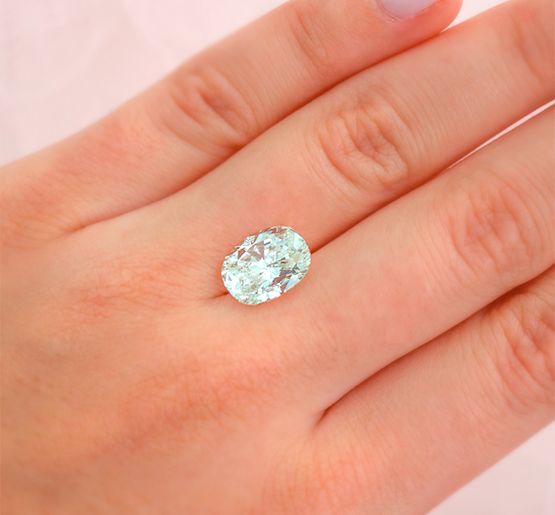
![]() .
Prequalify now
.
Prequalify now
